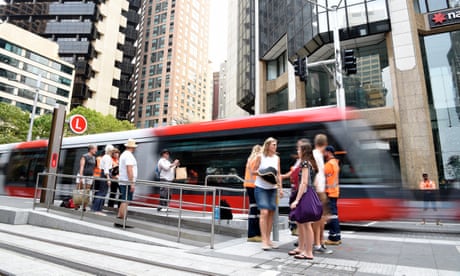- by foxnews
- 03 Apr 2025
Ping-pong tables and free transit: plan to bring Sydney’s CBD back from the dead
Ping-pong tables and free transit: plan to bring Sydney’s CBD back from the dead
- by theguardian
- 01 Feb 2022
- in news

Free public transit within Sydney's central business district to encourage commuters to explore the city is part of an ambitious CBD revitalisation plan the New South Wales government will consider.
Under the plan, Indigenous culture and history would be better integrated into the cityscape for both locals and tourists, with Aboriginal languages and stories embedded into street signs, and Indigenous art in public spaces.
The ideas are key recommendations that will be delivered to the NSW government on Tuesday as part of the Future of the Sydney CBD report, a study conducted by global design and planning firm Arup with the Committee for Sydney and led by industry leaders across the business, academia, art and Indigenous communities.
The Commission into the Future of the Sydney CBD was formed in late 2020, with the goal of improving Sydney's liveability, creativity and investment issues that have existed both before and after the Covid pandemic.
Of the 47 recommendations the NSW government will consider, key areas of focus include making the CBD an easier and more appealing destination to travel around and spend time in, embedding an Indigenous identity to the landscape, encouraging greater investment and reducing pollution.
Light-centric art installations should also become a permanent CBD fixture, the commission believes, arguing it would harness the popularity of Sydney's Vivid light festival and become a year-round attraction, and make the city safer.
Popular pedestrian routes and crime data would be analysed to determine areas that would most benefit from permanent lighting installations.
In addition to establishing a free transit zone from the harbourfront through Chinatown and down to the southern fringe of the CBD to encourage a "stay-a-while" mentality among office workers - similar to the free tram zone in Melbourne - the commission also recommends discounting travel into the city from suburban areas at night.
Precincts in Sydney's CBD should also be designated as different villages - similar to Wall Street and Broadway in New York - the commission argues, to allow areas with distinct characters to emerge.
A permanent 24-hour fresh produce and street food marketplace as well as a public performance amphitheatre should also be established, and cultural institutions such as galleries should be funded to open late every night of the week, the report urges.
While fostering a greater night-time economy has been a goal of NSW's government since the reversal of the lockout laws, the commission also calls for measures to encourage more people to use the CBD during the daytime given the future of work-from-home conditions ushered in by the pandemic.
The commission recommends more places for people to sit for free, including seating with tables and sufficient rain and shade cover, as well as exercise equipment and ping-pong tables.
Childcare options within the CBD should also be heavily subsidised to encourage workers to come back into the office - however the commission recommends private employers pilot this initiative.
Gabriel Metcalf, chief executive of the Committee for Sydney, said: "Sydney has one of the great CBDs in the world, but the question everyone's trying to figure out now is what the changes from Covid are going to mean for it."
Metcalf said the city doesn't need a wholesale reinvention, but rather "new layers - more reasons for more different kinds of people to visit and spend time in the city".
"That means doubling down on public space and amenity, really trying to make it a place centred on people and somewhere they can't resist spending time," he said.
Stuart Ayres, the NSW minister for tourism, said the recommendations would complement the government's existing revitalisation efforts, noting a $50m fund to woo people back into the CBD, which has already including a long lunch voucher scheme.
Ayres said: "This is about transforming Sydney's CBD from a nine-to-five workplace to a 24-hour global playground for innovation, entertainment and culture, and boosting new opportunities to attract investment and global talent."
While the NSW government has unveiled a $1bn support package for businesses following the explosion of the Covid over summer, the challenges facing the CBD following the Omicron wave are unclear.
Movement data of Sydney commuters analysed during non-locked-down periods of 2021 found an emerging trend among workers to work from home on Monday and Friday and cluster their commuting days during the week.
- by foxnews
- descember 09, 2016
Flight passenger says man deliberately squatted in window seat, ignites social media debate
An airline flyer said a seat squatter tried to tell her to swap seats with him, but she stood her ground, prompting a social media debate. A travel expert weighs in.
read more


